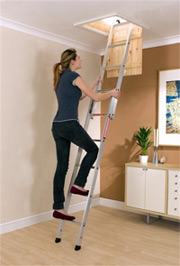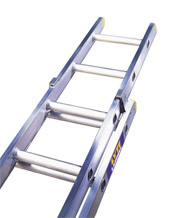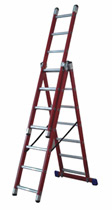Types of Ladders
 Some ladders may only elevate the user a few feet from the ground (Stepstools), while others provide access to a third story roof (Extension Ladder). Then there are the modern combination ladders, which can provide everything from scaffolding to painting support. It is all a question of need, storage and manoeuvrability.
Some ladders may only elevate the user a few feet from the ground (Stepstools), while others provide access to a third story roof (Extension Ladder). Then there are the modern combination ladders, which can provide everything from scaffolding to painting support. It is all a question of need, storage and manoeuvrability.
The most common ladder is called step ladders or A-frame ladders. A small step ladder may be used indoors to get to hard to reach storage spaces or to repairs or odd jobs around the house. A-frame ladders are often used to reach a bit further perhaps four feet or so from the ground. Step and A-frame ladders use fairly wide treads (steps) for stability and usually fold together for easy storage. Step and A-frames ladders are generally not expensive and should provide enough elevation for everyday tasks around the house.
 There are then the Ladders that reach the sides of your home for painting or roofs for maintenance, extension ladders are a must. Extension ladders fold down to the length of one section for storage, and are available in single, double, and triple sections. Unlike the self-supporting A-frame design, extension ladders are usually propped against walls or other sturdy surfaces for support. The legs have adjustable foot pads which provide level contact with the ground. The rungs of many extension ladders are usually either square or D-rung, unlike the wide and flat treads of step ladders. Wearing proper footwear is essential when working with extension ladders, since the rungs can become oily or wet over time.
There are then the Ladders that reach the sides of your home for painting or roofs for maintenance, extension ladders are a must. Extension ladders fold down to the length of one section for storage, and are available in single, double, and triple sections. Unlike the self-supporting A-frame design, extension ladders are usually propped against walls or other sturdy surfaces for support. The legs have adjustable foot pads which provide level contact with the ground. The rungs of many extension ladders are usually either square or D-rung, unlike the wide and flat treads of step ladders. Wearing proper footwear is essential when working with extension ladders, since the rungs can become oily or wet over time.
In the extension ladder range there are different variations available; one option is the Roof Ladder. These ladders should extend a few feet past the edge of the roof. With safety in mind these ladders have hooks on the end. Roofing ladders can be used as regular extension ladders, but extension ladders should not be used as roof ladders this will loose the safety aspect.
Ladder Materials
 Ladders are made of different types of materials. Ladders always used to be constructed from wood, but today you can select from wood, aluminum or fibreglass. Wood is still preferred by many for its durability, low cost and non-conductivity. Wooden ladders can be heavier but are prone to damage from insects and weather exposure. Aluminium ladders are valued for being lightweight yet strong and a high resistance to climate. Remember metal ladders are hazardous when exposed to electrical sources. Aluminium also tends to bend easily under pressure, so for more industrial type work a heavy duty or rope operated version should be an option. Aluminium ladders are ideal for indoor usage and outdoor projects too.
Ladders are made of different types of materials. Ladders always used to be constructed from wood, but today you can select from wood, aluminum or fibreglass. Wood is still preferred by many for its durability, low cost and non-conductivity. Wooden ladders can be heavier but are prone to damage from insects and weather exposure. Aluminium ladders are valued for being lightweight yet strong and a high resistance to climate. Remember metal ladders are hazardous when exposed to electrical sources. Aluminium also tends to bend easily under pressure, so for more industrial type work a heavy duty or rope operated version should be an option. Aluminium ladders are ideal for indoor usage and outdoor projects too.
Fibreglass Ladders are non-conductive, which makes them perfect for outdoor work and roofing. Fibreglass is also resistant to insect damage and exposure to the elements. Unlike aluminium, fibreglass frames won't bend easily under normal pressure, although they may snap suddenly under stress. Fibreglass is not a lightweight material either.
